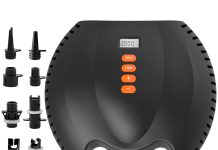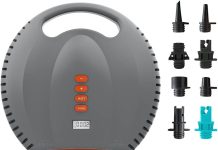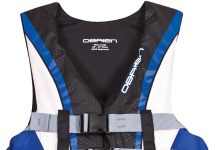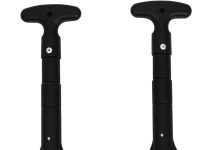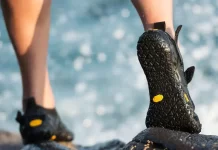Are you an avid stand-up paddleboarder looking to avoid shoulder injuries? Look no further! In this article, we’ll uncover some practical tips and techniques to keep your shoulders safe and sound while enjoying the exhilarating sport of SUP paddling.
Whether you’re a beginner or an experienced paddler, we’ve covered you. So grab your board, and let’s dive into SUP without fearing shoulder injuries!
Choosing the Right Equipment
Selecting a Suitable SUP Board
Choosing the right equipment is crucial when avoiding shoulder injuries while SUP paddling. It starts with selecting a suitable SUP board for your skill level and body weight. A board that is too small or unstable can strain your shoulders and lead to injury. Conversely, a board that is too large can be challenging to maneuver, causing unnecessary stress on your shoulders. Finding the right SUP board that provides stability, control, and comfort can significantly reduce the risk of shoulder injuries during paddling sessions.
Using the Correct Paddle
Equally important as selecting the right board is using the correct paddle. A too-long or short paddle can negatively impact your shoulder health. When the paddle is the correct length, it allows you to maintain the proper posture and engage the right muscle groups without putting undue stress on your shoulders. It is recommended to choose an adjustable paddle so that you can customize the length to suit your height and paddling style. Additionally, consider the material of the paddle to ensure it is lightweight and comfortable to hold, minimizing strain on your shoulders.
Wearing a Properly Fitted Leash
While it may not seem directly related to shoulder injury prevention, wearing a properly fitted leash is essential for keeping your shoulders safe during SUP paddling. A leash helps to ensure that you and your board are connected, preventing unnecessary strain on your shoulders if you fall off the board or get separated. Choosing a leash that is the correct length for the conditions you will be paddling in is essential. A too-long leash can cause the board to react unpredictably, potentially leading to shoulder injuries. Additionally, ensure the leash fits snugly and comfortably around your ankle to avoid unnecessary pulling on your shoulders.
Ensuring Proper Technique
Maintaining an Upright Posture
Maintaining an upright posture while SUP paddling is essential for avoiding shoulder injuries. Slouching or hunching over puts excessive strain on your shoulders, leading to fatigue and potential injury. Instead, focus on keeping your back straight, shoulders relaxed, and head aligned with your spine. Distribute your weight evenly on the board, engaging your core muscles to stabilize your body. Maintaining an upright posture reduces the strain on your shoulder joints, allowing for a more comfortable and injury-free paddling experience.
Engaging the Core Muscles
Engaging your core muscles is beneficial for stability and plays a crucial role in protecting your shoulders. Activating your core muscles provides a solid foundation for your upper body and helps maintain proper paddling alignment. This takes the pressure off your shoulders, allowing them to move more efficiently and reducing the risk of injury. Incorporate exercises that target your core, such as planks and Russian twists, into your fitness routine to strengthen these muscles and improve your SUP paddling technique.
Utilizing Proper Paddle Stroke
Using the correct paddle stroke technique is vital for avoiding shoulder injuries and maximizing the efficiency of your strokes. Begin by ensuring your grip on the paddle is correct, with one hand on the top of the paddle and the other hand holding the shaft a comfortable distance down. As you paddle, rotate your core and utilize the strength of your torso and upper body rather than relying solely on your shoulders and arms. This reduces the strain on your shoulder joints and helps generate more power and momentum. Focus on a smooth and fluid stroke, keeping your elbows slightly bent, and avoid excessively reaching or overextending your arms, which can put unnecessary stress on your shoulders.
Warming Up and Stretching
Performing Shoulder-Targeted Warm-Up Exercises
Before getting on the water, warming up your shoulder muscles is crucial to prevent injuries. Perform shoulder-targeted warm-up exercises to increase blood flow, loosen up the muscles, and improve mobility. Some practical warm-up exercises include arm circles, shoulder rolls, and shoulder stretches. These exercises help to prepare your shoulder joints and surrounding muscles for the physical demands of SUP paddling, reducing the risk of strains or sprains.
Stretching the Shoulder Muscles
Stretching the shoulder muscles is essential in preventing shoulder injuries during SUP paddling. Incorporate dynamic stretches, such as shoulder rotations and extensions, into your warm-up routine to improve your shoulders’ flexibility and range of motion. It is also beneficial to include static stretches, such as the cross-body shoulder stretch and the overhead triceps stretch, after your paddling session to aid recovery and maintain shoulder flexibility. Regularly stretching your shoulder muscles can help prevent tightness, reduce the risk of overuse injuries, and improve overall shoulder health.
Gradually Increasing Intensity
Starting with Shorter Sessions
When starting with SUP paddling or returning after a hiatus, it is essential to begin with shorter sessions and gradually increase the intensity. Rapidly jumping into long, intense paddling sessions can strain your shoulders excessively and increase the risk of injury. Instead, start with shorter sessions of 20-30 minutes and gradually extend the duration as your shoulder strength and endurance improve. This gradual progression allows your shoulder muscles to adapt and build strength safely and flexibly.
Progressing to Longer Distances Gradually
Similarly to starting with shorter sessions, gradually increasing the distance you paddle is critical to avoiding shoulder injuries. Instead of attempting long-distance paddles immediately, gradually build up your endurance by adding a few extra minutes or kilometers to your paddling distance each week. This progressive approach allows your shoulders and supporting muscles to adapt and become stronger. Listening to your body and not pushing yourself beyond limits is essential to prevent overexertion and potential shoulder injuries.
Incrementally Adding Intense Training
If you want to add more intense training to your SUP paddling routine, it is crucial to do so incrementally to avoid shoulder injuries. Introduce elements like interval training, speed drills, or paddling against resistance gradually, allowing your shoulders to adapt to the increased demands. Pushing yourself too hard too quickly can lead to overuse injuries, strains, or rotator cuff issues. Be mindful of your body’s response to the added intensity and adjust accordingly to maintain a healthy, injury-free shoulder.
Listening to Your Body
Recognizing Pain or Discomfort
One of the most important aspects of avoiding shoulder injuries when SUP paddling is listening to your body and recognizing signs of pain or discomfort. If you experience persistent pain, sharp cramps, or aching in your shoulders during or after paddling, it is crucial not to ignore these signals. Pain in the shoulder can indicate underlying issues, such as tendonitis or impingement, and continuing to paddle through the pain can worsen the condition. Take any pain or discomfort seriously and address it promptly to prevent further injury.
Taking Breaks and Resting if Needed
If you feel fatigued or notice any early signs of shoulder strain during a paddling session, don’t hesitate to take breaks and rest. Pushing through fatigue or ignoring warning signs can lead to overuse injuries and prolonged recovery time. Take short breaks to stretch and relax your shoulders, allowing the muscles time to recover and recharge. Remember, taking a break and preventing a potential injury is better than pushing yourself and facing a more extended period of healing and rehabilitation.
Seeking Medical Attention if Symptoms Persist
If you experience persistent shoulder pain, limited range of motion, or ongoing discomfort even after resting and taking preventive measures, it is crucial to seek medical attention. A healthcare professional, such as a sports medicine specialist or physical therapist, can assess your shoulder condition, provide an accurate diagnosis, and recommend appropriate treatment options. Ignoring persistent symptoms can lead to further damage and potentially more long-term consequences, so it is essential to address any shoulder issues promptly.
Maintaining Good Muscle Strength and Flexibility
Incorporating Regular Strength Training
It is beneficial to incorporate regular strength training into your fitness routine to support your shoulder health and avoid injuries. Focus on exercises that target the muscles surrounding the shoulder joint, such as the deltoids, rotator cuff muscles, and upper back muscles. Resistance training with dumbbells, resistance bands, or bodyweight exercises like push-ups and pull-ups can help strengthen these muscles, providing stability and reducing the risk of shoulder injuries during SUP paddling. Consult a fitness professional to design a well-rounded, customized strength training program for optimal shoulder health.
Implementing a Balanced Workout Routine
In addition to strength training, it is essential to implement a balanced workout routine to maintain overall muscle strength and flexibility. Incorporate exercises targeting different muscle groups, including the core, legs, and back, to prevent muscle imbalances contributing to shoulder injuries. A balanced workout routine helps to promote overall body strength and stability, reducing the strain on your shoulders during SUP paddling. Consider activities like yoga, Pilates, or functional training to improve flexibility and engage various muscle groups, complementing your SUP paddling workouts.
Including Specific Shoulder Strengthening Exercises
To specifically target and strengthen the shoulder muscles, include exercises that focus on improving the stability and mobility of the shoulder joint. These can include exercises like external and internal rotations, scapular retractions, and rows. By strengthening the muscles around the shoulder joint, you provide better support and protection during SUP paddling. A physical therapist or a qualified fitness professional can guide you in performing these exercises correctly and create a customized program to address any individual needs or weaknesses in your shoulder muscles.
Avoiding Overexertion and Fatigue
Knowing Your Limits
Understanding and respecting your limits is crucial in avoiding shoulder injuries during SUP paddling. Pushing yourself past your physical capabilities can lead to excessive strain and fatigue on your shoulders, increasing the risk of injury. Be mindful of your fitness level, the conditions of the water, and the duration and intensity of your paddling sessions. Recognize when you are beginning to feel fatigued and adjust your activity level accordingly. By staying within your limits, you can maintain proper form, prevent overuse injuries, and enjoy a safer and more enjoyable paddling experience.
Avoiding Overtraining
While it is essential to challenge yourself and progress in your SUP paddling skills, it is equally important to avoid overtraining. Overtraining occurs when you exceed your body’s capacity to recover, leading to fatigue, weakened immunity, and increased injury risk. Allow your body time to rest and recover between paddling sessions. Incorporate rest days into your schedule to prevent overuse injuries and allow your shoulders to recover and rebuild. Balance your paddling workouts with other fitness activities to prevent overtraining and maintain a healthy balance.
Getting Sufficient Rest and Recovery
Rest and recovery are essential components of preventing shoulder injuries when SUP paddling. Your shoulder muscles need time to repair and rebuild after the physical demands of paddling. Aim for at least 7-8 hours of quality sleep each night to promote optimal recovery. Additionally, incorporate active recovery strategies like foam rolling, gentle stretching, or low-impact activities on rest days to enhance blood flow, reduce muscle tension, and promote overall shoulder health. Prioritize rest and recovery as an integral part of your SUP paddling routine to avoid overexertion and maintain healthy shoulders.
Using Protective Gear
Wearing a Padded Paddle Glove
Consider wearing a padded paddle glove to provide added protection and support to your shoulders during SUP paddling. Padded gloves can help cushion your hands and reduce the impact and strain on your shoulders, particularly during longer paddling sessions or challenging conditions. The padding absorbs vibrations and shock, minimizing the risk of shoulder injury. Choose a glove that fits snugly and allows for a comfortable grip on the paddle, ensuring maximum control and minimizing the risk of slippage.
Using Shoulder Braces or Supports if Necessary
If you have a history of shoulder injuries or experience ongoing shoulder instability, using shoulder braces or supports may be beneficial. These braces or supports provide additional stability and compression to the shoulder joint, reducing the risk of further injury or strain. Consult with a healthcare professional or a sports medicine specialist to determine whether a shoulder brace or support is appropriate for your needs. They can help recommend the most suitable type of brace or support and provide guidance on proper usage.
Considering Paddle Technique Modifications
If you are experiencing persistent shoulder discomfort or are prone to recurring shoulder injuries while SUP paddling, consider paddle technique modifications may be necessary. Adjustments such as shortening your stroke, using a lower hand position on the paddle, or reducing the resistance during the pull phase can help alleviate stress on your shoulders. Working with a SUP instructor or coach can provide valuable insights into proper technique modifications tailored to your needs. By optimizing your paddle technique, you can minimize the strain on your shoulders and enjoy a safer and more comfortable paddling experience.
Paying Attention to Environmental Factors
Accounting for Wind and Current Conditions
Environmental factors like wind and currents can significantly impact the stress placed on your shoulders during SUP paddling. Before heading out, check the weather forecast and be aware of the wind direction and strength. Paddling against a strong headwind can strain your shoulders while paddling with the wind at your back may provide less resistance. Similarly, understanding the direction and speed of currents in the water can help you plan your paddling routes and avoid areas where excessive effort or strain may be required. By accounting for these factors, you can adjust your paddling technique and intensity, minimizing the risk of shoulder injuries.
Avoiding Hazardous Water Areas
Another essential consideration for shoulder injury prevention during SUP paddling is identifying and avoiding hazardous water areas. These include areas with solid surf, rocky seabeds, submerged obstacles, or heavy boat traffic. Navigating hazardous conditions can increase the risk of falling off your board or colliding with objects, potentially leading to shoulder injuries. Familiarize yourself with the water conditions and potential hazards of your paddling location, and make informed decisions to ensure your safety. Choosing calmer waters and steering clear of hazardous areas will decrease the likelihood of accidents and protect your shoulders from unnecessary strain.
Being Mindful of Waves and Choppiness
The waves and choppiness in the water can challenge your shoulder health during SUP paddling. When encountering waves, it is crucial to maintain a stable and balanced posture to absorb the impact. Bending your knees slightly and engaging your core helps to stabilize your body, reducing the strain on your shoulders as you navigate through the waves. Adjust your paddle stroke to adapt to the uneven water surface, focusing on maintaining control rather than relying on excessive power. By being mindful of waves and choppiness, you can protect your shoulders from sudden jolts and maintain a safe and enjoyable paddling experience.
Receiving Professional Instruction
Enrolling in SUP Paddling Classes
Enrolling in SUP paddling classes can be highly beneficial to ensure proper technique and minimize the risk of shoulder injuries, especially if you are a beginner. Qualified instructors can teach you the correct paddle stroke technique, proper body positioning, and essential safety measures. They can also provide personalized feedback and guidance for improving your technique and avoiding unnecessary strain on your shoulders. Learning from experienced professionals in a structured environment allows you to develop solid fundamentals, fostering a safe and enjoyable SUP paddling experience.
Seeking Coaching or Training from Experts
If you want to refine your SUP paddling skills or address specific concerns related to shoulder health, seeking expert coaching or training is a valuable investment. Experienced SUP trainers or coaches can assess your current technique, identify areas for improvement or modifications, and offer targeted exercises or drills to enhance your shoulder strength and stability. Whether you are training for competitive paddling or aiming to optimize your paddling efficiency, receiving expert guidance and feedback can significantly reduce the risk of shoulder injuries and help you achieve your performance goals.
Mastering Proper Technique through Guidance
Mastering proper technique is critical to avoiding shoulder injuries when SUP paddling. While it is possible to learn through self-practice and online resources, receiving professional guidance provides the most effective way to develop correct form and minimize the risk of injury. Regular guidance and feedback help ensure that you use the correct paddle stroke technique, engage the right muscles, and maintain proper posture. By mastering proper technique through guidance, you can maximize your paddling efficiency, minimize strain on your shoulders, and enjoy the many benefits of SUP paddling with reduced risks of injury.
In conclusion, you avoid shoulder injuries when SUP paddling requires a combination of preventive measures, technique refinement, and listening to your body. By choosing the right equipment, maintaining proper technique, warming up and stretching adequately, gradually increasing intensity, maintaining good muscle strength and flexibility, avoiding overexertion and fatigue, using protective gear, paying attention to environmental factors, and seeking professional instruction when needed, you can significantly reduce the risk of shoulder injuries and ensure a safe and enjoyable SUP paddling experience. Remember to prioritize your shoulder health, take necessary precautions, and always paddle within your limits. Happy paddling!


